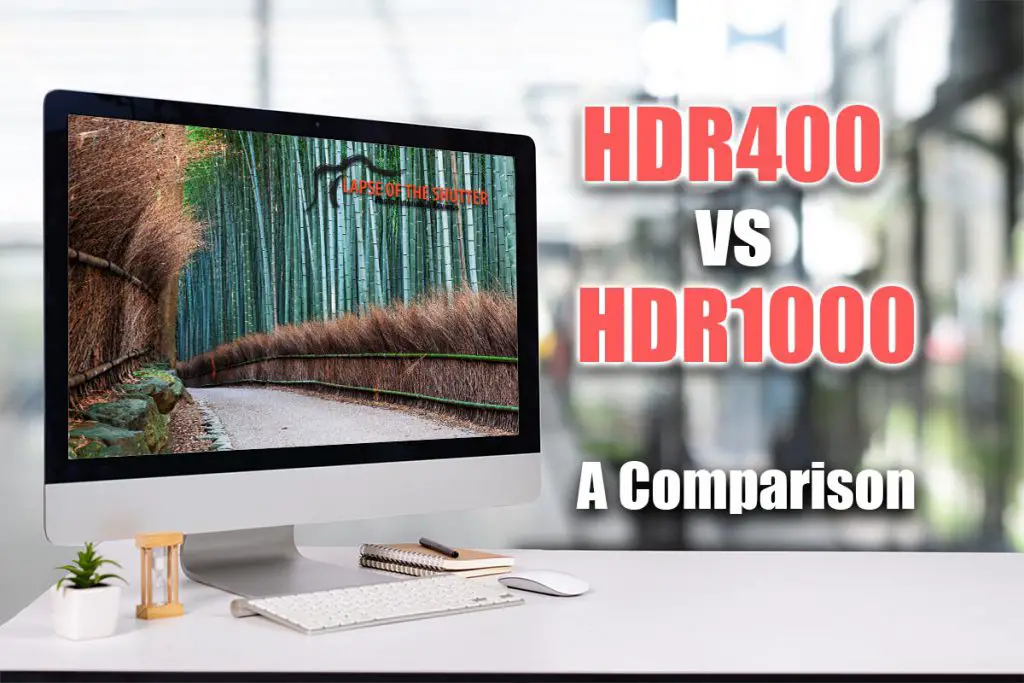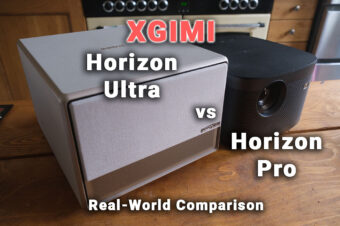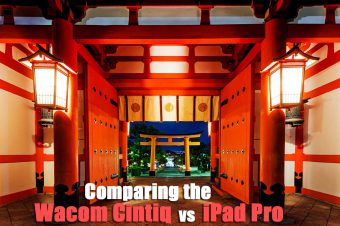Comparing HDR400 vs HDR1000, HDR400 refers to the ability of a monitor to display a minimum peak luminance of 400cd/m2, while HDR1000 means that the monitor can meet a minimum peak luminance of 1000cd/m2, plus has a lower black point, better active dimming and a wider color gamut.
Both HDR 400 and HDR 1000 are terms that are thrown around regularly by manufacturers, slapped on their monitors without necessarily meeting the more rigourous VESA DisplayHDR standards.
HDR itself stands for High Dynamic Range, and means that a monitor can display a wider range of tones from true black to true white than a non-HDR monitor, but it doesn’t have a specific definition itself, leading to confusion about what terms like HDR400 and HDR1000 actually mean.
This isn’t helped by lax, unofficial standards from some monitor manufacturers who use the official DisplayHDR standards interchangeably with HDR terminology.
This article will cover the differences between HDR400 and HDR1000, clearing up any confusion and showing you exactly what each mean.

The Difference Between HDR 400 vs HDR 1000
HDR400 is considered the first entry point to HDR monitors, and is generally available on cheaper and entry-level models today.
It means that a monitor can meet a peak brightness of 400cd/m2, although there is no specification that states how long it must maintain this brightness level, or under what conditions, meaning that it is often abused in practice.
HDR1000 is currently the highest level of HDR technology available, and broadly means that a monitor can meet 1000cd/m2 of peak brightness.
Again though, this might only be for a fraction of a second in a limited part of the screen for the manufacturer to claim that their monitors meet HDR 1000.
This means that strictly speaking, HDR 400 and HDR 1000 as labels are largely meaningless.
The reason that so many monitors claim these labels is because they are attempting to trick consumers who believe that an HDR400 or HDR1000 label refer to the more rigorous, professional DisplayHDR 400 and DisplayHDR 1000 standards assigned by VESA.
These DisplayHDR standards are the real deal, and mean not only that a monitor meets a certain specification, but that it can do so consistently under independent test conditions. Any monitor that passes a DisplayHDR level can use the official VESA certified logo.

The current performance criteria for DisplayHDR state:
Display HDR400 – for Entry-Level Devices
- A true 8-bit image
- Global dimming
- Peak luminance of 400 cd/m2 in 10% center patch test and flash test
- Peak luminance of 320 cd/m2 sustained for 30 minutes over the entire screen
- High color gamut at 95% sRGB, but doesn’t offer DCI-P3 wide color gamut
Display HDR1000 – for Professional and Enthusiast Monitors
- 10-bit image processing
- Local dimming offers 2x more contrast than DisplayHDR 600
- Peak luminance of 1000 cd/m2 in 10% center patch test and flash test
- Peak luminance of 600 cd/m2 sustained for 30 minutes over the entire screen
- Very high color gamut at >99% sRGB and 90% of the wide color gamut DCI-P3
HDR1000 vs HDR400 Summary
If you see a label like, “HDR400” or “HDR1000” on a monitor, it often only means that the monitor can briefly reach a peak luminance of 400 nits or 1000 nits respectively.
On the other hand, if you see, “DisplayHDR400” or “DisplayHDR1000”, along with the VESA certified logo, then you can be sure that your monitor meets much stricter standards on brightness, color gamut and global or local dimming.
You can see an official list of monitors that meet the DisplayHDR400 and DisplayHDR1000 standards at the links.
You can compare HDR 1000 and HDR 400 monitors in the video below, but note that it is best to see this in real life to get a real feel for the differences.
HDR400 and HDR1000 in Practice
We’ve seen what the actual standards for these HDR specifications are, but what difference do they make in practice?
Although HDR400 is much better than standard monitors, it is still lacking in comparison to HDR1000 in terms of:
- Global dimming rather than local dimming
- Local peak luminance and therefore lower contrast
- No wide color gamut support
There are also some small technical differences, but these are less relevant in practice.
For general use, the differences listed above matter very little, so the extra price tag of an HDR1000 monitor is unlikely to be good value for money.
But where HDR1000 comes into its own is really in photo editing, graphic designing and gaming.
Photo editing and other visual disciplines require a large color gamut to ensure that you are seeing accurate colors, and that any prints you make or images that you pass on to others fully represent your vision. For this, access to the DCI-P3 gamut is ideal, which means that HDR1000 monitors are likely to be a far better bet for you.

For gaming, color gamut matters much less, but improved contrast and local dimming really come into their own. The greater brightness of the monitor allows for far more detail to be seen in dark and light areas, giving you a sharper image. Local dimming means that brightness can be varied independently in different areas of the panel, agin helping with more realistic contrast.
HDR1000 monitors also tend to come with a faster refresh rate, although this is not specified in the standard.
But, in order to use HDR 1000 for gaming, you do need to be using a compatible game. Although you will see some advantages with games that are not directly setup to model the standard, you see much better results with games remastered to meet the DisplayHDR standards.
Is HDR always a good thing?
Although HDR gives you much sharper, clearer images, there are some situations where it might not be advisable to use HDR.
In general, HDR will give you access to brighter, clearer colors, which is a good thing in most cases, but might obscure details if the software you are using is not setup for HDR support, or if you don’t calibrate your monitor effectively.
You also should see much more detail in bright and dark areas, but again, for something like photo editing where you are trying to make an image with pure black, you might struggle to do this accurately with an HDR monitor.
Final Thoughts: Display HDR400 vs Display HDR1000
In general, HDR1000 is always going to give a better image than a monitor with HDR400. The only real area where HDR400 comes out on top is in terms of price, as these are the more entry-level monitors when compared to the top-end HDR1000 monitors.
DisplayHDR 400 is the start of the VESA accredation, which currently ends at DisplayHDR 1400, and includes several true black standards. If you’re not sure whether HDR is for you, then HDR400 monitors can be a good starting point, and you will see a tremendous difference over standard, non-HDR monitors, even at this lowest specification.
Read More:
Hisense Roku TV not turning on? Try this…
What’s the best monitor for photo editing on a budget?






Leave a Reply